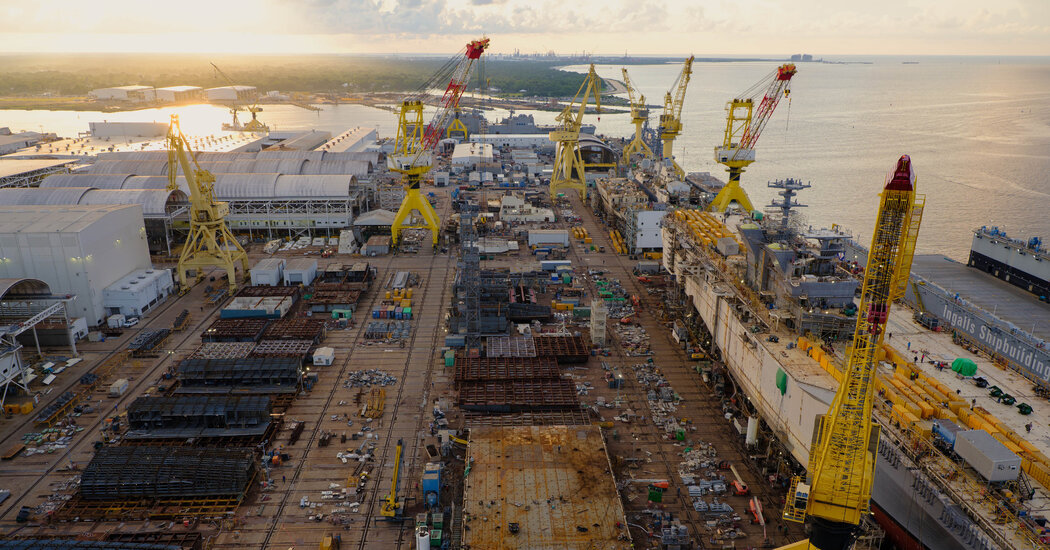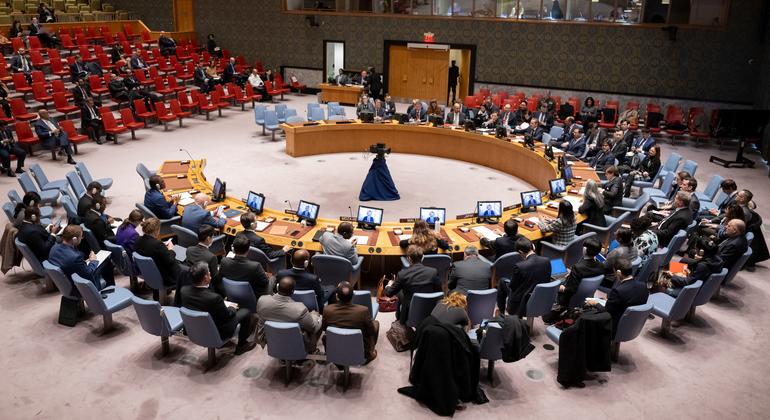[ad_1]
A symphony of kinds echoed by means of the sprawling shipyard on the Gulf Coast of Mississippi — banging, hissing, beeping, horns, bells and whistles — as greater than 7,000 employees hustled to fill orders fueled by the most important shipbuilding finances within the Navy’s historical past.
The surge in spending, $32 billion for this 12 months alone, has allowed the Huntington Ingalls shipyard to rent 1000’s of further individuals to assemble guided missile destroyers and amphibious transport ships. “Extra ships are all the time higher,” stated Kari Wilkinson, the president of the shipyard, pointing to the efficiencies that include a gentle circulate of contracts and the roles they create.
However the focus from Washington on producing a stream of recent warships can also be making a fleet that some contained in the Pentagon assume is just too wedded to outdated army methods and that the Navy won’t be capable of afford to maintain operating in a long time to come back.
Half a world away, at a U.S. Navy outpost in Bahrain, a a lot smaller crew was testing out a really totally different method to the service’s Twenty first-century warfighting wants.
Bobbing in a small bay off the Persian Gulf was a set of tiny unmanned vessels, prototypes for the form of cheaper, easier-to-build and extra cellular pressure that some officers and analysts of naval warfare stated was already serving to to include Iran and might be important to combating a warfare within the Pacific.
Working on a finances that was lower than the price of gas for one of many Navy’s massive ships, Navy personnel and contractors had pieced collectively drone boats, unmanned submersible vessels and aerial autos able to monitoring and intercepting threats over tons of of miles of the Persian Gulf, like Iranian quick boats trying to hijack oil tankers.
Now they’re pleading for extra money to assist construct on what they’ve discovered.
“It’s an unbelievable functionality — we now have already examined it for one thing like 35,000 hours,” stated Michael Brown, who was the director of the Protection Innovation Unit, which helped arrange the unmanned drone checks in Bahrain. “So why are we not fielding that as quick as doable?”
The distinction between the approaches in Pascagoula and Bahrain helps as an instance one of many greatest challenges going through the Navy.
At no second since World Conflict II has the service confronted a extra pressing demand to embrace new applied sciences and weapons techniques, given the rising menace from a now formidable Chinese language army.
The Navy’s high brass talks incessantly about the necessity to innovate to handle the menace offered by China. The Protection Division’s personal warfare video games present that the Navy’s big-ship platforms are more and more weak to assault.
However the Navy, analysts and present and former officers say, stays lashed to political and financial forces which have produced jobs-driven procurement insurance policies that yield highly effective however cumbersome warships that is probably not ideally fitted to the mission it’s going through.
An aversion to risk-taking — and the breaking of traditions — blended with a bravado and confidence within the energy of the normal fleet has severely hampered the Navy’s progress, a number of just lately departed high-ranking Navy and Pentagon officers informed The New York Occasions.
“The U.S. Navy is smug,” stated Lorin Selby, who retired this summer time as a rear admiral and the chief of naval analysis after a 36-year profession during which he helped run most of the Navy’s main acquisition items. “We have now a vanity about, we’ve acquired these plane carriers, we’ve acquired these wonderful submarines. We don’t know the rest. And that’s simply improper.”
Resistance to risk-taking and alter for the army may also be discovered amongst members of Congress.
Management on Pentagon budgets on Capitol Hill is dominated by lawmakers from shipbuilding communities like Senator Roger Wicker, Republican of Mississippi. The trade directs tens of hundreds of thousands of {dollars} of marketing campaign contributions to key lawmakers and mounts lobbying campaigns pushing the Navy to construct extra ships.
In simply the previous eight years, Congress has added $24 billion in extra cash to construct ships, greater than some other a part of the Pentagon finances, at the same time as lawmakers have lower spending on repairs to the fleet, based on an evaluation by the Middle for Strategic and Budgetary Assessments.
Congress has additionally balked at efforts to retire older ships that the Navy says present solely marginal warfighting capability, leaving the service susceptible to not having the ability to afford primary upkeep and staffing prices.
The end result, officers acknowledge, has been to convey into focus how gradual the Navy has been to supply the funding and a focus to the speedy innovation that many analysts say is important — at the same time as cash pours into typical shipbuilding applications.
Capt. Alex Campbell of the Navy, whose job this 12 months has been to seek out methods to purchase cheaper, sooner, extra revolutionary know-how, stated the amount of cash that had been allotted to the hassle to date was minuscule.
“It’s the mud particle on the pocket lint of the finances,” he stated.
Nobody is arguing that the Navy now not wants conventional warships; in reality, a big fleet of fast-attack submarines could be significantly very important in any battle with China.
To many analysts, trade executives and present and former army officers, the open query is how rapidly the Navy can embrace the tactical alternatives by additionally arming itself with a brand new era of weapons which can be extra maneuverable, cheaper to construct and fewer devastating to lose. At the same time as the large shipyards are booming, corporations that make unmanned platforms like these being evaluated in Bahrain are struggling to stay afloat.
“Proper now, they’re nonetheless constructing a largely Twentieth-century Navy,” stated Bryan Clark, a former Navy finances planner who serves as a advisor to the service.
The most important obstacles to reworking the Navy embrace its antiquated procurement system, which takes years to construct out detailed specs for brand spanking new ships after which years extra to get cash allotted to construct them.
The Navy should additionally radically revamp the way in which it organizes its fleet, critics of the present system say, to raised permit its giant platform ships to function alongside a various fleet of unmanned vessels to raised accumulate data on threats and immediately launch assaults.
Commanders who’re comfy with decades-old techniques and ideas are having a tough time accepting the necessity for modifications, a number of just lately departed Navy officers stated.
Navy leaders have stated they’re dedicated to shifting to a brand new operational method they’re calling “distributed maritime operations,” a mix of conventional ships and unmanned drones that may permit them to unfold out their forces.
In a press release to The Occasions, Carlos Del Toro, the secretary of the Navy, stated the service had made “profound progress” over the previous two years in beginning to modernize its fleet. It’s getting ready to take further steps quickly, he stated, together with the creation of a unit referred to as the Disruptive Capabilities Workplace.
“I’m doing every thing in my energy to make sure that we keep on the forefront of constructing the warfighting capabilities and industries of the long run,” stated Mr. Del Toro, a former commander of a guided missile destroyer inbuilt Pascagoula. “We’re dedicated to innovation and advancing technological advances to take care of our strategic edge as a nation.”
However Adm. Michael M. Gilday, who till final month served because the chief of naval operations, conceded that the Navy had been taking solely cautiously measured steps.
“Revolutionary change is actually arduous, and we’ve discovered typically the arduous means after we transfer too quick, we make massive errors,” Admiral Gilday stated in a speech this 12 months. “And so our path actually has been extra evolutionary. It’s been extra deliberate, however it has been centered.”
A Mississippi Empire
1000’s of employees in arduous hats pour by means of the gates on the Huntington Ingalls shipyard in Pascagoula earlier than the pre-dawn horn sounds at first of a shift, providing a daily reminder of what an unlimited operation the shipbuilding effort is right here — the most important manufacturing employer in Mississippi.
Probably the most outstanding of the 4 courses of ships the shipyard produces are the Arleigh Burke guided-missile destroyers, 509-foot vessels which can be thought-about the workhorses of the Navy.
The destroyers can deal with a variety of missions, together with looking down and destroying enemy submarines, attacking different ships in close by waters and firing precision missiles to strike far-off targets on land. The Navy already has 73 of them and has offers to construct 16 extra, at a price ticket of about $2 billion apiece.
The issue is that regardless of their superior energy, a majority of these destroyers, like sure different conventional warships, are more and more weak — particularly in a battle with China over Taiwan, based on repeated warfare recreation workout routines performed by the Pentagon, its contractors and out of doors consultants.
China has constructed up its personal navy and air pressure, in addition to an elaborate community of anti-ship missiles alongside its southern and japanese coasts and on islands it has constructed within the South China Sea.
The dangers to U.S. Navy ships in any battle in that area are so extreme that the USA is left with two undesirable choices, based on researchers at RAND Company, a assume tank that has run a collection of warfare recreation workout routines for the Pentagon.
If the Navy ships select to method China, many might be hit by Chinese language missiles and broken if not destroyed, leading to misplaced U.S. ships and casualties on a scale unseen since World Conflict II, the warfare video games repeatedly concluded.
“We lose lots of people, we lose lots of gear, we often fail to attain our goal,” David A. Ochmanek, a former deputy assistant secretary of protection who now works at RAND, stated throughout a public dialogue of a few of the analysis, a abstract he reiterated in a current interview.
Alternatively, the ships will keep tons of and even 1000’s of miles from the world, making it a lot more durable for Navy plane or missiles to succeed in their targets and leaving the preliminary engagement largely to Air Power bombers, Navy submarines and a few long-distance Navy strikes, the warfare recreation workout routines concluded.
“What it comes all the way down to is, in lots of instances, the Navy floor fleet doesn’t play a serious position,” stated Michael Bohnert, a warfare video games engineer at RAND.
Among the finest methods for the Navy to counter this problem, Mr. Ochmanek stated, could be to quickly deploy a fleet of armed, unmanned vessels and drones that may get near Chinese language targets. However, he added, “I’ve not been impressed with the velocity at which they’re shifting on that.”
As a substitute, the talk in Washington stays largely centered on defending and increasing conventional platforms.
The Pentagon this 12 months proposed delaying the acquisition of one of many ships, referred to as an amphibious transport dock, that Huntington Ingalls builds at its Pascagoula yard, citing the rising price.
Many times, lawmakers pressed Navy officers to not delay, and assume tanks and consulting corporations funded by the shipbuilders pushed out opinion items as a substitute urging the Navy to construct extra manned ships.
In a press release to The Occasions, Mr. Wicker stated he had pushed the Navy to embrace unmanned vessels in addition to to construct conventional ships. “Backing conventional platforms or shifting utterly towards superior know-how is a false selection,” he stated.
Shipbuilders and different contractors that present gear put in on these ships have additionally flooded lawmakers with marketing campaign contributions, totaling greater than $90 million simply previously 5 years. A number of the largest chunks of that cash went to lawmakers who lead the finances and Pentagon oversight committees, together with Mr. Wicker.
Huntington Ingalls, like the opposite main contractors, additionally has its personal small military of lobbyists. They embrace two former Home leaders (Richard A. Gephardt, Democrat of Missouri, and Robert Livingston, Republican of Louisiana, who was the speaker-designate earlier than resigning) and a former Senate majority chief (Trent Lott, Republican of Mississippi), in addition to Haley Barbour, the previous Mississippi governor and Republican Nationwide Committee chairman.
When the Senate moved this summer time to undertake its invoice authorizing Pentagon spending for the 2024 fiscal 12 months, it referred to as for the Navy to maneuver forward with building of the extra ship sought by Mr. Wicker, regardless of the Pentagon’s push for a delay.
Quickly after that transfer, the Navy introduced a multibillion-dollar dedication by means of 2027 to construct 9 extra of the destroyers at Pascagoula and a second personal shipyard, which can assist guarantee job safety for 1000’s of employees. Even earlier than that, Huntington Ingalls, which just lately started to name itself HII, informed buyers it was carrying a $46.9 billion backlog of orders for ships, the most important in its historical past.
Experiment within the Persian Gulf
On a bay simply off the Persian Gulf, two very uncommon Navy vessels moved about: one constructed for velocity, the opposite endurance, however each unmanned. They have been there to assist observe and intercept threats from Iran, which has been seizing oil tankers and harassing ships passing by means of a significant choke level of worldwide commerce.
One, the T-38 Satan Ray, which might attain speeds of as much as 90 miles per hour — sooner than simply about some other vessel within the Navy — was awaiting its subsequent task. Alongside it was the Ocean Aero Triton, whose solar-power system permits it to function for 3 months at a time with none must refuel.
With extra U.S. warfighting property shifted towards Asia, the Navy’s Fifth Fleet — which covers a 2.5 million-square-mile expanse that encompasses the Persian Gulf and a part of the Indian Ocean — has had to determine how you can do extra with much less.
The experiment behind the Satan Ray and the Triton, nicknamed Activity Power 59, has grow to be a fulcrum for the talk over whether or not the army is shifting quick sufficient to embrace new and extra versatile methods of adapting to a altering menace atmosphere.
The experiment in Bahrain began after Admiral Selby, then the chief of the Workplace of Naval Analysis, proposed that the Navy check out a few of the unmanned vessels as a part of an annual Navy train off San Diego in early 2021. He stated he discovered huge enthusiasm for the thought amongst frontline commanders within the Pacific and the Center East.
“We try to enhance Navy energy, however we have to do greater than that: We have to reimagine Navy energy,” he stated in an interview this summer time, simply after retiring from the Navy. “We’re form of at a pivotal level in historical past. It’s critical that we throw off previous conventions.”
The hassle in Bahrain took off with the assist of Vice Adm. Brad Cooper, the commander of Navy forces within the area. However it was a shoestring effort, led by Capt. Michael D. Brasseur, who had labored on an analogous venture for NATO.
The Navy had already contracted with conventional suppliers like Boeing and L3Harris to develop unmanned vessels with names like Orca, Snakehead and Sea Hunter. However a number of of these tasks have been already years delayed and tremendously over finances — or had such extreme issues they have been quietly canceled.
The crew in Bahrain took a really totally different method, turning to smaller, extra entrepreneurial corporations and sidestepping the paperwork that slows and complicates massive weapons applications. It discovered companions in corporations like Saildrone, Anduril, Defend AI and Martac, which had by no means constructed a serious Navy ship.
Activity Power 59 additionally used inventive enterprise fashions to get the revolutionary vessels within the water rapidly. Saildrone, of Alameda, Calf., makes surveillance vessels that function on their very own for as much as a 12 months. However fairly than shopping for the vessels, the Navy bought the information they have been amassing, saving on upkeep in addition to acquisition prices.
Most of the new breed of vessels and drones don’t carry weapons, however their refined cameras, mine-sensing units and different sensors permit the Navy fleet primarily based in Bahrain to maintain watch over a bigger chunk of the waters it patrols.
“It’s a gigantic improve in consciousness of what’s taking place and thus rising your skill to reply,” Admiral Cooper stated.
When Iran started to intercept oil tankers this 12 months, the unmanned vessels for the primary time have been used to guide the patrol, navigating by means of the Strait of Hormuz forward of the U.S. army ships.
“The cameras on these boats are fairly wonderful — you may see individuals’s expressions, learn their title tags, even see their facial hair,” Captain Brasseur stated.
Provided that warfare video games had demonstrated the necessity for 1000’s of unmanned units for surveillance, interdiction and assault functions to arrange for any battle with China, Admiral Selby pushed colleagues on the Pentagon to determine a technique to quickly purchase 1000’s of comparable units for the Navy to make use of worldwide.
However repeatedly, he stated, he bumped into roadblocks. He proposed that the Navy create a brand new high-ranking officer who would have the authority and funding to construct a so-called hybrid fleet during which the brand new era of unmanned autos would function at the side of conventional warships.
The response he stated he obtained from the Navy: It didn’t have an accessible “billet” — authorization to fill a high-ranking publish — to observe up on his plan.
“You now run up towards the machine — the individuals who simply wish to form of proceed to do what we’ve all the time carried out,” Admiral Selby stated. “The budgeting course of, the congressional course of, the commercial lobbying efforts. It’s all designed to proceed to supply what we’ve already acquired and make it somewhat higher. However that isn’t adequate.”
The Navy has agreed to increase the experiment performed in Bahrain to a minimum of one different a part of the world, round Latin America, principally for immigration and drug interdiction efforts. However to date it has not adopted detailed new operational methods that may govern how you can combine these unmanned platforms broadly throughout the Navy nor allotted giant sums of cash to begin shopping for them.
The contractors which have constructed these unmanned drones are nonetheless ready for main orders, though commanders from varied Navy fleets have made clear they’re anxious for their very own allotment of the brand new instruments.
“There simply just isn’t the management on the high to say, ‘Get it carried out,’” stated Richard Jenkins, the founder and chief government officer of Saildrone, whose surveillance vessel Navy officers stated had been probably the most worthwhile instruments demonstrated out of Bahrain.
The corporate might ship as many as 400 of its vessels a 12 months. However to date, it has Navy contracts for less than 16, together with the six nonetheless getting used round Bahrain.
The same sentiment was expressed by Ken Perry, a former nuclear submarine captain who’s now an government at ThayerMahan, a Connecticut-based firm that has invented an unmanned machine that tracks enemy submarines at a fraction of the price of the massive vessels the Navy makes use of.
“They refuse to take cash from the legacy applications,” Mr. Perry stated. “The Navy, massive trade and different key stakeholders are vested within the present shipbuilding enterprise.”









